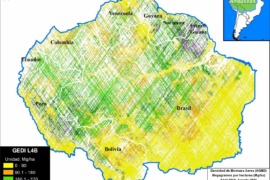MAAP #160: Lasers Estimate Carbon in the Amazon – NASA’s GEDI Mission
NASA’s GEDI mission uses lasers to provide cutting-edge estimates of aboveground biomass and related carbon on a global scale. Launched in late 2018 and installed on the International Space Station, GEDI’s lasers return an estimate of aboveground biomass density at…

